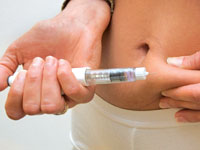
Injecting insulin above and to the side of the belly button can result in more consistent results.
(ISTOCKPHOTO)
"In general if a patient has a hemoglobin A1C that is higher than the agreed upon goal and they are not on insulin, we recommend insulin therapy," Dr. Hellman says. The American Diabetes Association (ADA) recommends an A1C of 7% or below, and the American College of Endocrinology and the American Association of Clinical Endocrinologists recommend an A1C of 6.5% or below.
If you can't lower your A1C with diet, exercise, or other medications, you may need insulin to do the job.
Exceptions to the insulin rule
There are exceptions, of course. Someone who otherwise seems to be a good candidate for insulin may not be able to manage such a regimen if he or she has limited vision and dexterity and no family support.
Good News About Today's Improved Insulins

Andy switched to once-a-day insulin and uses shorter, thinner needles Read more
The goal is to mimic the pancreas
The different types of insulin mimic the natural rhythm of a healthy pancreas, which produces a consistent low level of the hormone and occasional bursts of insulin to cope with postmeal boosts in blood sugar.
According to the American Diabetes Association (ADA), your need for insulin is based on several factors.
• How long you have had diabetes
• Your blood glucose level
• What other medicines you take
• Your overall health
As diabetes progresses, you may be more likely to need insulin
In type 2 diabetes the body is resistant to insulin. The beta cells in the pancreas churn out insulin as fast as they can to overcome this insulin resistance. This Herculean task can eventually exhaust the beta cells and diminish their ability to produce insulin, potentially resulting in them being unable to produce any insulin at all.
Although early treatment to reduce blood sugar can help save the beta cells, diabetes is a progressive disease. Sometimes, particularly if diabetes is diagnosed a decade or more after its onset, the beta cells are too far gone to salvage, and you may need to take insulin permanently.
Last Updated: April 24, 2008
